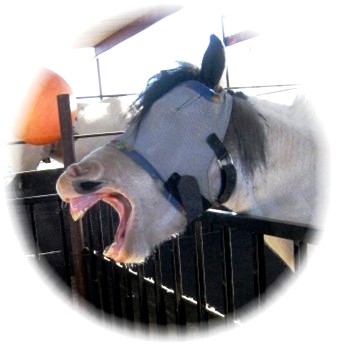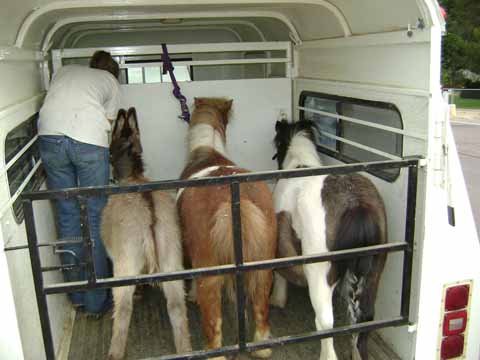How Do I Know If My Horse's Teeth Need Floating?
I Am Ranch Miniature Horses is sharing with you what we do to maintain the health of our horses. This is not intended to direct you on how to care for your horse. The intent of this is only to share what we do, and raise questions for you. We advise you to consult your veterinarian before making any changes in your horse's health care. The information found on our website is not to supersede the advise of your veterinarian. I AM Ranch Miniature Horses cannot be held liable for the care of your horse(s).
 |
Be sure to check out
this brand new book from our favorite miniature horse dentist - Carl
Mitz!
Development of Dentition in Small Equine and Related Cases
Miniature Horses seem to have more problems with their teeth than the big horses. They have the same amount of teeth and similar size, just squished in a smaller mouth. Miniatures tend to not shed their caps (baby teeth) and this is one cause of problems. I have seen this on one of our big Paints, too. Sometimes the upper jaw does not grow as fast as the lower and can cause permanent undershot jaw if the ridges on the teeth is not removed. Most minis have teeth that are not sized down enough. Mini teeth are said to be softer than the big horses. Click here to see our trip to the dentist with a big horse. This page has many surgery videos on it. This horse had perfect body condition. |
|
The following is a list of
signs for you to use as an aid, but remember that many horses don't show
any of these signs and are in desperate need of a dentist. Most dentists do not charge you
to look in the mouth and tell you your horse's teeth condition, but
there are some signs you can look for so that you can judge the need
yourself. Drops food when eating
Cribs or chews wood
|
 "Four Butts" on their way to the dentist! |
|
This fun chart shows you how to age a horse by looking at the teeth! |
|
Where to Hang My Horse's Feeder?
An interesting side note about feeders. Horses were designed to eat with their heads low to the ground. We have had dentists tell us that wall feeders help keep them in business. When a horse eats with its head up, the teeth do not align properly and the teeth wear unevenly. The higher head causes the jaw to slide back changing the alignment of the contact surfaces. They develop hooks on the lower molars due to the unbalanced wear on the teeth.
If your feeders are down at ground level, the jaw slides forward, and therefore wears their teeth in a more efficient pattern. Also helpful in maintaining a balanced mouth is grazing of coarse grass. Horses on a pellet, sweet feed, softer hay diet will tend to need care more often to keep a balanced mouth.
And, read below to see what we do while waiting for our horses to wake back up if they are sedated during dental work!
Sheath Cleaning
When our boy horses are anesthetized/sedated for any reason (often done after a teeth float), I use that opportunity of relaxation to clean their sheath. Here are instructions placed first told to me by Carol Zills of Zill farms.
Mr. Hand (Sheath Cleaning without Fuss)
By Patricia Harris
Copyright 1998 Patricia Harris
Step 1) Check to make sure there are no prospective boyfriends,
elderly
neighbours, or Brownie troops with a line of sight to the
proceedings.
Though of course they're probably going to show up unexpectedly
ANYWAY once
you're in the middle of things. Prepare a good explanation.
2) Trim your fingernails short. Assemble horse, hose, and your sense
of
humour (plus, ideally, Excalibur cleanser and perhaps thin rubber
gloves).
3) Use hose (or damp sponge) to get the sheath and its inhabitant
wet. Uh,
that is, do this in a *civilized* fashion with due warning to the
horse; he
is apt to take offense if an icy-cold hose blasts unexpectedly into
his
personal regions.
4) Now introduce your horse to Mr Hand. What I find safest is to
stand
facing the horse's head, with my shoulder and hip snugly against the
horse's
thigh and hip so that if he makes any suspicious move such as
raising his
leg, I can feel it right away and am in any case pressed so close
that all
he can do is shove, not really kick. The horse should be held by an
assistant or by your free hand, NOT tied fast to a post or to
crossties. He
may shift around a good bit if he's not happy with Mr Hand's antics,
but
don't be put off by that; as long as you are patient and gradual,
and stick
close to his side, he'll get over it.
Remember that it would be most unladylike of you to simply make a
direct
grab for your horse's Part. Give the horse a clue about what's on
the
program. Rest your hand against his belly, and then slide it back
till you
are entering The Home of the Actual Private Part. When you reach
this first
region of your destination, lube him up good with Excalibur or
whatever
you're using.
If the outer part of his sheath is really grungy you will feel
little clods
and nubblies of smegma peeling off as you grope around in there.
Patiently
and gently expedite their removal.
5) Thus far, you have probably only been in the outer part of the
sheath.
The Part Itself, you'll have noticed, is strangely absent. That's
because it
has retired shyly to its inner chambers. Roll up them thar sleeves
and
follow in after it.
6) As you and Mr Hand wend your way deeper into the sheath, you will
encounter what feels like a small portal that opens up into a
chamber
beyond. Being attentive to your horse's reaction, invite yourself
in. You
are now in the inner sanctum of The Actual Private Part. It's hiding
in
there towards the back, trying to pretend it isn't there. Say hi and
wave to
it.. No, really, work your finger back and forth around the sides of
it. If
the horse won't drop, this is your only shot at removing whatever
dried
smegma is clinging to the surface of the Part itself. So, gently
explore
around it, pulling out whatever crusty topsoil you find there. Use
more
water and more Excalibur if necessary to loosen attached gunk.
7) When Mr Hand and the Actual Private Part have gotten to know each
other
pretty well, and the Part feels squeaky clean all around, there
remains only
one task: checking for, and removing, the bean. The bean is a pale,
kidney-shaped accumulation of smegma in a small pouch just inside
the
urethra. Not all horses accumulate a bean, but IME the majority do,
even if
they have no visible external smegma. So: the equine urethra is
fairly large
diameter, and indeed will permit you to very gently insinuate one of
your
slimmer fingers inside the urethral opening. Do so, and explore
upwards for
what will feel like a lump or "pea" buried no more than, I dunno,
perhaps
3/4" in from the opening. If you do encounter a bean, gently and
sympathetically persuade it out with your finger. This may require a
little
patience from BOTH Mr Hand AND the horse, but the horse will be
happier and
healthier once it's accomplished. In the rare event that the bean is
too
enormous for your finger to coax out, you might try what I did (in
desperation) last month on the orange horse: Wrap thumb and index
finger
around the end of the Part and squeeze firmly to extrude the bean.
Much to
my surprise it worked and orange horse did NOT kill me for doing it
and he
does not seem to have suffered any permanent damage as a result. I
have
never in my life seen another bean that enormous, though.
8) Now all that's left to do is make a graceful exit and rinse the
area very
thoroughly in apology for the liberties you've taken. A hose will be
MUCH
easier to use here than just a sponge and bucket, IME. Make sure to
direct
the water into the Part's inner retreat too, not merely the outer
part of
the sheath. This may require you to enfold the end of the hose in
your hand
and guide it up there personally.
9) Ta-da, you are done! Say, "Good horsie" and feed him lots of
carrots.
Watch him make funny faces at the way your hands smell. Hmm. Well,
perhaps
there is ONE more step...
10) The only thing I know of that is at all effective in removing
the lovely
fragrance of smegma from your hands (fingernails arms elbows and
wherever
else it's gotten) is Excalibur. Even then, if you didn't use gloves
you may
find you've got an unusual personal perfume for a while. So, word to
the
wise, do NOT clean your horse's sheath just before an important job
interview or first date.
and of course, there is that one FINAL step...
11) Figure out how to explain all this to your mother (or the kid
from next
door, or the meter reader, or whoever else you've just realized has
been
standing in the barn doorway speechlessly watching the entire
process).
Now, go thou forth and clean that Part!

